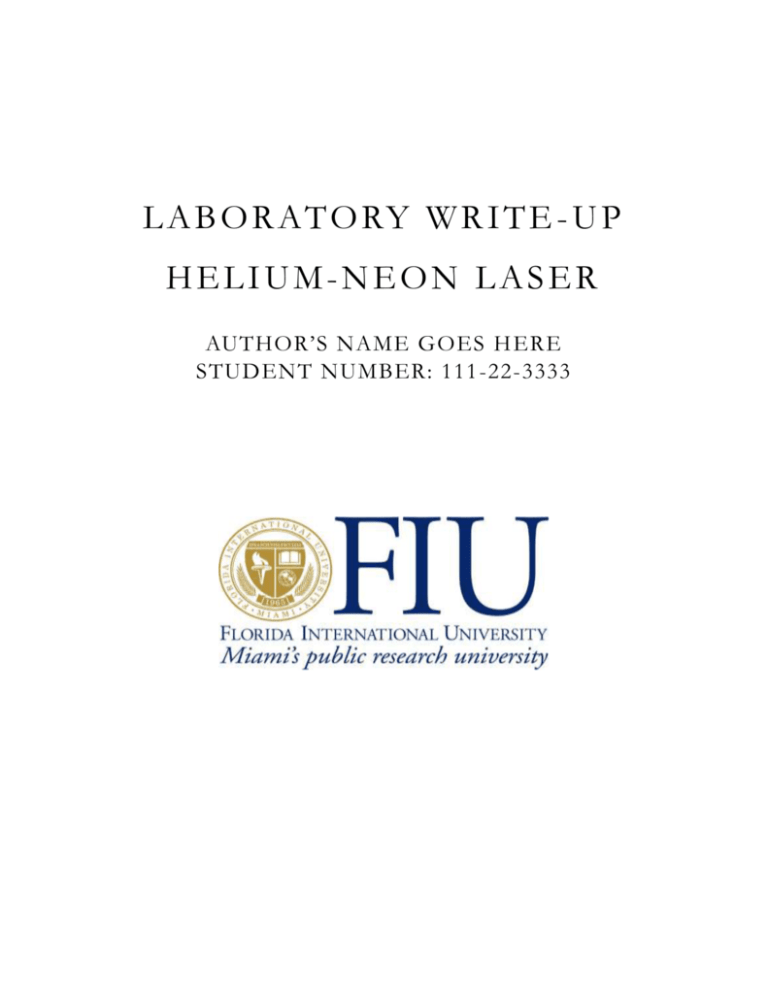22-Laser
advertisement

L A B O R AT O RY W R I T E - U P HELIUM-NEON LASER AUTHOR’S NAME GOES H ERE STUDENT NUMBER: 111 -22-3333 HELIUM-NEON LASER 1 . P U R P OS E Laser is an acronym for light amplification by stimulated emission of radiation. The basic components of a laser are: 1) An "active or amplifying material" where atoms and radiation interact. 2) A mechanism to create a greater population of atoms in an excited state than exists in a lower state, i.e. "population inversion". 3) A resonant cavity with a resonant frequency equal to the photon frequency. A schematic diagram of the helium-neon laser is shown in Fig. 1. Initially, electron impact excites helium atoms to the 21S0 and 23S1 states as shown in Fig. 2. Transitions back to the 11S0 state by electric dipole radiation are forbidden; hence these excited states are "metastable". However, during collisions, these atoms can transfer their energy to neon atoms in the 2p6 state, promoting them to the 2p55s and 2p54s states ("resonant energy exchange"). Stimulated emission occurs between each of these excited neon states and the lower 2p53p state resulting in 632.8 nm visible light and 1.15 μm infrared radiation respectively. The gas mixture is contained in a glass tube with highly reflective mirrors at each end which cause standing waves of wavelength 632.8 nm to be set up, but also permit a small fraction of the radiation to emerge as output. It is the photons that are reflected back and forth that are responsible for stimulated emission of further photons from excited neon atoms. Since all the photons are in phase, the output is highly coherent. Part of this experiment involves spectroscopy using a diffraction grating spectrometer. A grating and its geometry are shown schematically in Fig. 3. Waves reflected from adjacent reflecting surfaces will do so constructively if d(sin in - sin out) = m , m = 0,1,2,... ....(1) 2 The spectrometer will be used to determine the laser wavelength as well as to examine related transitions in a neon gas discharge tubes. Also in this experiment, the efficiency of the laser and the beam divergence will be measured. 2 . P R OC E D U R E Spectroscopy NEVER TOUCH THE SURFACE OF THE GRATING. TO DO SO DESTROYS IT. Carefully remove the grating from the spectrometer. Adjust the telescope eyepiece until the crosshairs are arranged like an X and in sharp focus. Focus the telescope on infinity. Illuminate the slit with the mercury discharge tube (WHICH OPERATES AT A FEW THOUSAND VOLTS, SO BEWARE) and adjust the collimator only for a sharp, narrow, vertical image of the slit when viewed through the telescope. Rotate the telescope until the slit image is precisely centered on the crosshairs, then adjust the circular scale to 0o. The spectrometer is now to be aligned so that in is (approximately) 65o. To achieve this, rotate the telescope clockwise through 50o (i.e., meas = 50o), place the grating on the table and then rotate the center table until the slit image is again centered on the crosshairs. You are now viewing the m = 0 spectrum, for which all spectral lines are superimposed. The m = 1 spectrum, which is to be used, will be found to the left of this position. Finding in: Measure the angular positions of in by finding the (m=0) superposition of the lines. [This will look like the image of the slit opening to the spectrometer.] At this measured angle, inout. Be sure and pay attention to the difference between the angle you measure and the incoming and outgoing angles for the laser light. [See the figure at left.] 3 Finding d: Measure the angular positions of the two yellow (579.1 and 577.0 nm), the green (546.1 nm) and blue (435.8 nm) lines. Measure the corresponding values of out and, from equation 1, obtain average values for d and in. (This should correspond to approximately 1200 grooves per mm.) Note that you have the equivalent of 2 unknowns and four equations (of the form of equation 1, but for the four values of given by the two yellow, the green and the blue lines. Finding laser Replace the mercury tube with the neon tube and also arrange the laser so that the beam is directed at an angle towards the slit as shown in Fig. 4. In this way, only laser light scattered from the edges of the slit will pass through the spectrometer. Direct light is too intense and could damage your eye. Determine the wavelength of the laser line. Does the laser line coincide with any of the neon lines? Explain why it does or does not. Efficiency Use the Metrologic photometer to measure the power output of the laser. Start with the range switch on the highest setting and then decrease it as necessary. Determine the power input to the laser from voltage and current measurements. Express the efficiency as a percentage. Beam Divergence Take the laser into the hallway and measure the beam diameter at 1 m intervals from the laser from zero up to 10 m. Reduce the beam intensity as necessary using the polarizing filters. If the beam is too bright, accurate measurements are difficult. Plot a graph of beam width vs distance and use it to calculate the beam divergence. Compare this with the diffraction-limited beam divergence, diff, given by diff ~2 /d where d is width of the beam aperture and is given by the width of the beam very close to the laser. 2






